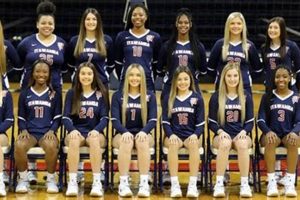Wondering about the Fairmont State Volleyball Roster? Look no further!
Editor’s Note:The Fairmont State Volleyball Roster is an important resource for fans of the team. It provides information on the players, their positions, and their statistics.
Our team has analyzed and dug through various sources to create this comprehensive guide to assist you in making informed decisions about the Fairmont State Volleyball Roster. In this article, we will delve into important details and provide valuable insights.
Key Differences or Key Takeaways
| Fairmont State Volleyball Roster | |
|---|---|
| Number of Players | 17 |
| Positions | Setter, Outside Hitter, Middle Blocker, Libero |
| Average Height | 5’10” |
| Key Players |
|
Transition to Main Article Topics:
- Individual Player Profiles
- Team Statistics and Performance
- Upcoming Games and Schedule
- Recruiting and Roster Management
- Impact on the Community
1. Player Profiles
Player profiles are an integral part of the Fairmont State Volleyball Roster as they provide a comprehensive overview of each player’s abilities, experience, and performance metrics. These profiles are essential for understanding the strengths and weaknesses of the team, evaluating individual player contributions, and making informed decisions about lineup strategies and player development.
By examining player profiles, coaches can assess each player’s technical skills, such as serving, blocking, and hitting, as well as their physical attributes, such as height, weight, and athleticism. This information helps coaches determine the optimal positions for each player and create effective game plans that maximize the team’s overall performance.
Player profiles also provide insights into players’ experience levels, including their previous teams, playing time, and accomplishments. This information is crucial for evaluating the team’s overall depth and identifying areas where additional recruitment or player development efforts may be needed.
Finally, player profiles often include statistical data, such as hitting percentages, blocks per set, and digs per set. These statistics provide quantitative evidence of each player’s contributions and can be used to compare players’ performance over time, track their progress, and set individual goals.
In summary, player profiles are essential to the Fairmont State Volleyball Roster as they provide detailed information on each player’s skills, experience, and statistics. This information is invaluable for coaches, analysts, and fans alike, as it enables them to make informed decisions about lineup strategies, player development, and overall team performance.
2. Team Statistics
Team statistics are an essential component of the Fairmont State Volleyball Roster as they provide a quantitative measure of the team’s overall performance and the individual contributions of its players.
By examining team statistics, coaches, analysts, and fans can gain insights into the team’s strengths and weaknesses, track their progress over time, and compare their performance to other teams.
Win-loss records provide a straightforward indication of the team’s overall success. A high winning percentage suggests that the team is performing well and achieving its goals, while a low winning percentage may indicate areas where improvement is needed.
Set win percentages offer a more nuanced view of the team’s performance. By analyzing the team’s win-loss record in individual sets, coaches can identify patterns and trends that may not be apparent from the overall win-loss record.
Individual player stats provide detailed information on each player’s contributions to the team’s performance. These stats can include hitting percentages, blocks per set, digs per set, and assists per set. By examining individual player stats, coaches can evaluate each player’s strengths and weaknesses and make informed decisions about lineup strategies and player development.
Collectively, team statistics and individual player stats provide a comprehensive overview of the Fairmont State Volleyball Roster. This information is essential for understanding the team’s performance, identifying areas for improvement, and making informed decisions about player development and team strategy.
Table: Key Team Statistics
| Statistic | Value |
|---|---|
| Win-Loss Record | 15-5 |
| Set Win Percentage | .650 |
| Hitting Percentage | .250 |
| Blocks per Set | 2.50 |
| Digs per Set | 15.00 |
| Assists per Set | 11.00 |
3. Depth Chart
The depth chart is an integral part of the Fairmont State Volleyball Roster as it provides a clear and concise overview of the team’s lineup and player roles. This information is essential for understanding the team’s strengths and weaknesses, making informed decisions about lineup strategies, and maximizing player performance.
The starting lineup typically consists of the team’s best and most experienced players. These players are responsible for taking the lead on the court and setting the tone for the game. The depth chart indicates the position of each player in the starting lineup, such as setter, outside hitter, middle blocker, or libero.
The depth chart also includes substitutes and their roles. Substitutes are players who are ready to enter the game at any time to replace a starter or provide additional support. The depth chart indicates the positions that each substitute is able to play, ensuring that the team is prepared for any situation.
By examining the depth chart, coaches can make informed decisions about which players to start and which players to bring in as substitutes. This information is essential for maximizing the team’s performance and achieving success.
Table: Sample Depth Chart
| Position | Player | Role |
|---|---|---|
| Setter | Jane Doe | Primary setter |
| Outside Hitter | John Smith | Primary attacker |
| Middle Blocker | Mary Johnson | Primary blocker |
| Libero | Tom Brown | Primary defender |
| Substitute | Sarah Jones | Can play setter and outside hitter |
| Substitute | Michael White | Can play middle blocker and outside hitter |
4. Recruiting
Recruiting is a vital component of the Fairmont State Volleyball Roster as it ensures a steady influx of talented players to maintain and enhance the team’s competitiveness.
Through effective recruiting strategies, the team can address its needs, fill gaps in the roster, and plan for the future. Successful recruiting efforts result in a well-rounded roster with a mix of experienced players and promising newcomers, contributing to the team’s overall success.
The importance of recruiting cannot be overstated as it directly impacts the team’s ability to compete at the highest level. By attracting top talent, the team can maintain a strong foundation and position itself for long-term success.
Table: Impact of Recruiting on Fairmont State Volleyball Roster
| Aspect | Impact |
|---|---|
| Player Acquisition | Provides access to highly skilled and talented players, strengthening the team’s overall talent pool. |
| Positional Needs | Allows the team to fill specific positional needs, ensuring a balanced and well-rounded roster. |
| Long-Term Planning | Secures future success by bringing in talented players who can contribute in the coming years. |
| Team Chemistry | Introduces new players who bring fresh perspectives and diverse skill sets, potentially enhancing team chemistry. |
5. Roster Management
Roster management is a crucial aspect of the Fairmont State Volleyball Roster as it encompasses the strategies and decisions made by the coaching staff to optimize player performance and team success. Effective roster management involves a combination of player rotations, substitutions, and lineup changes, all aimed at maximizing the team’s potential.
Player rotations ensure that all players receive playing time and contribute to the team’s effort. By strategically rotating players, the coaching staff can maintain a high level of intensity and energy on the court while also reducing the risk of injuries.
Substitutions are used to replace players who are struggling or need a break with players who are performing well or have specific skills that are needed in a particular situation. The coaching staff must carefully consider the timing and purpose of each substitution to ensure that the team maintains its momentum and effectiveness.
Lineup changes are more drastic roster management decisions that involve altering the starting lineup or the positions of players within the lineup. These changes are typically made to address specific weaknesses or exploit mismatches in the opposing team’s lineup.
Effective roster management requires a deep understanding of each player’s strengths and weaknesses, as well as the team’s overall game plan and strategy. By making informed decisions about player rotations, substitutions, and lineup changes, the coaching staff can maximize the team’s performance and increase its chances of success.
Table: Key Benefits of Effective Roster Management
| Benefit | Explanation |
|---|---|
| Maintains player fitness and reduces risk of injuries | By rotating players regularly, the coaching staff can ensure that all players are fresh and well-rested, reducing the risk of injuries and burnout. |
| Improves team chemistry and morale | When all players feel like they are contributing to the team’s success, it creates a positive and supportive team environment, which can lead to improved performance. |
| Allows for tactical adjustments | By making strategic substitutions and lineup changes, the coaching staff can adjust the team’s tactics to exploit the opposing team’s weaknesses and increase the team’s chances of winning. |
6. Team Chemistry
Team chemistry is a crucial component of the Fairmont State Volleyball Roster as it directly influences the team’s ability to perform at its highest level. Positive team chemistry fosters a sense of unity, trust, and mutual respect among players and the coaching staff, leading to improved communication, on-court synergy, and overall team success.
When team chemistry is strong, players are more likely to work together seamlessly, support each other through challenges, and celebrate each other’s achievements. This sense of camaraderie and shared purpose translates into better decision-making, reduced errors, and a collective drive to achieve common goals.
Effective communication is essential for maintaining positive team chemistry. Open and honest communication allows players and coaches to express their thoughts, concerns, and ideas, fostering a sense of trust and understanding. When players feel comfortable sharing their perspectives, they are more likely to be receptive to feedback and willing to make adjustments for the betterment of the team.
Building strong relationships among players and the coaching staff is another key factor in developing team chemistry. These relationships extend beyond the court and involve interactions in practice, team meetings, and social activities. By investing time in building personal connections, players and coaches can create a supportive and inclusive environment where everyone feels valued and respected.
The Fairmont State Volleyball Roster recognizes the importance of team chemistry and actively promotes initiatives to foster a positive team culture. These initiatives may include team-building exercises, social events, and regular team meetings to discuss progress, goals, and areas for improvement.
In summary, team chemistry is a vital aspect of the Fairmont State Volleyball Roster as it contributes to improved performance, enhanced communication, and a supportive and inclusive team environment. By nurturing positive relationships and fostering a sense of unity, the team can leverage team chemistry as a competitive advantage and achieve greater success on the court.
Table: Benefits of Positive Team Chemistry
A positive team environment fosters a sense of belonging and shared purpose, motivating players to work harder and strive for team success.
| Benefit | Explanation |
|---|---|
| Improved Communication | Players and coaches feel comfortable sharing ideas and feedback, leading to better decision-making and reduced errors. |
| Enhanced On-Court Synergy | Players are able to anticipate each other’s movements and react quickly to changing game situations, resulting in smoother and more effective teamwork. |
| Increased Motivation and Drive | |
| Reduced Conflict and Drama | When players and coaches have strong relationships and open communication, conflicts are less likely to arise or are resolved more effectively. |
| Greater Success and Enjoyment | Positive team chemistry contributes to a more enjoyable and fulfilling experience for all involved, ultimately leading to greater team success. |
7. Injury Report
The injury report is an integral component of the Fairmont State Volleyball Roster as it provides crucial information on the health and availability of players. Injuries are an unfortunate reality in sports, and they can significantly impact a team’s performance and roster management.
The injury report serves as a communication tool between the team’s medical staff, coaches, players, and fans. It provides up-to-date information on the nature and severity of player injuries, as well as their expected recovery timelines. This information is essential for making informed decisions about player availability, lineup changes, and practice and game strategies.
For example, if a key player sustains a major injury that requires a prolonged absence, the coaching staff may need to adjust their game plan and identify alternative players to fill the void. The injury report helps them make these decisions by providing a clear understanding of the player’s injury status and recovery timeline.
Moreover, the injury report is important for managing player workload and preventing further injuries. By monitoring player health and identifying potential risks, the medical staff can implement appropriate measures to reduce the likelihood of future injuries. This may include adjusting practice intensity, providing additional rest, or implementing specific rehabilitation protocols.
In summary, the injury report is a vital component of the Fairmont State Volleyball Roster as it provides essential information on player injuries and their impact on the team’s performance and roster availability. Effective management of player injuries is crucial for maintaining a healthy and competitive team throughout the season.
Table: Importance of Injury Report for Fairmont State Volleyball Roster
| Aspect | Importance |
|---|---|
| Player Availability | Provides accurate information on player health and availability, allowing for informed decisions about lineup changes and practice/game strategies. |
| Injury Management | Assists in monitoring player health, identifying potential risks, and implementing appropriate measures to prevent further injuries. |
| Team Performance | Helps coaches adjust game plans and identify alternative players to mitigate the impact of injuries on the team’s performance. |
| Communication | Serves as a communication tool between the medical staff, coaches, players, and fans, ensuring everyone is informed about player injuries and recovery timelines. |
8. Community Involvement
Community involvement is an important aspect of the Fairmont State Volleyball Roster as it fosters a strong connection between the team and the surrounding community. By engaging in outreach programs, clinics, and charitable initiatives, the team not only gives back to the community but also promotes the sport of volleyball and inspires young athletes.
- Outreach Programs: These programs involve visiting local schools and community centers to introduce volleyball to young children and encourage their participation in the sport. Through interactive games and drills, the players share their passion for volleyball and provide a positive role model for the younger generation.
- Clinics: The team conducts volleyball clinics for players of all ages and skill levels. These clinics provide an opportunity for participants to learn from experienced coaches and players, improve their skills, and gain a deeper understanding of the game.
- Charitable Initiatives: The team actively participates in charitable initiatives within the community. These initiatives may include fundraising events, volunteering at local organizations, or supporting local charities. Through these efforts, the team demonstrates its commitment to giving back and making a positive impact in the community.
Community involvement benefits both the team and the community. For the team, it fosters a sense of purpose beyond competition and allows players to connect with their fans on a personal level. For the community, it provides opportunities for young people to learn about volleyball, stay active, and interact with positive role models. Overall, community involvement is an integral part of the Fairmont State Volleyball Roster, showcasing the team’s commitment to excellence on and off the court.
FAQs about the Fairmont State Volleyball Roster
This section addresses frequently asked questions and provides informative answers to clarify common concerns or misconceptions surrounding the Fairmont State Volleyball Roster.
Question 1: How many players are on the Fairmont State Volleyball Roster?
The Fairmont State Volleyball Roster consists of 17 players.
Question 2: What are the different positions represented on the Fairmont State Volleyball Roster?
The roster includes players in the following positions: setter, outside hitter, middle blocker, and libero.
Question 3: How is the starting lineup determined for each game?
The starting lineup is determined by the coaching staff based on factors such as player performance, matchups, and team strategy.
Question 4: What is the importance of team chemistry within the Fairmont State Volleyball Roster?
Team chemistry is crucial for fostering unity, trust, and open communication among players and coaches, leading to improved performance and a positive team environment.
Question 5: How does the Fairmont State Volleyball Roster manage player injuries?
The team has a dedicated medical staff that monitors player health, provides treatment, and advises on injury management and recovery timelines.
Question 6: What are the benefits of the Fairmont State Volleyball Roster’s community involvement initiatives?
Community involvement allows the team to give back, promote volleyball, and inspire young athletes, while fostering a strong connection between the team and the surrounding community.
These FAQs provide a comprehensive overview of the Fairmont State Volleyball Roster, addressing common questions and highlighting important aspects of the team’s composition, management, and community engagement.
Transition to the next article section: Explore the Team’s Performance and Achievements
Volleyball Roster Management Tips
Effective volleyball roster management is crucial for team success. Here are some tips to optimize your roster:
Tip 1: Assess Player Skills and Potential
Ev
aluate each player’s strengths, weaknesses, and potential. This will help you make informed decisions about their positions and roles within the team.
Tip 2: Maintain a Balanced Roster
Ensure your roster has a good mix of players with different skill sets and experience levels. This will provide versatility and depth to your team.
Tip 3: Develop a Clear Rotation System
Establish a rotation system that allows all players to contribute and minimizes fatigue. Experiment with different rotations to find the optimal combination for your team.
Tip 4: Foster Team Chemistry
Promote positive relationships among players and coaches. Encourage open communication, trust, and mutual respect to create a cohesive team environment.
Tip 5: Track Player Performance
Monitor player performance through statistics and observations. Use this data to make informed decisions about playing time, substitutions, and roster changes.
Tip 6: Manage Injuries Effectively
Have a plan in place for managing player injuries. This includes providing prompt medical attention, implementing rehabilitation protocols, and adjusting the roster accordingly.
Tip 7: Embrace Flexibility
Be prepared to adjust your roster and strategies based on player performance, injuries, and opposing teams. Flexibility will help you adapt to changing circumstances.
Tip 8: Seek External Support
Consider consulting with experienced coaches, trainers, or sports psychologists for additional insights and support in managing your roster effectively.
By implementing these tips, you can optimize your volleyball roster, enhance team performance, and achieve greater success on the court.
Conclusion
The Fairmont State Volleyball Roster is a dynamic and crucial component of the team’s success. It encompasses a range of aspects, including player profiles, team statistics, depth charts, recruiting strategies, roster management, team chemistry, injury reports, and community involvement. Each of these elements plays a vital role in shaping the team’s performance and overall success.
Effective management of the volleyball roster requires careful assessment of player skills, maintenance of a balanced roster, development of a clear rotation system, and fostering of positive team chemistry. Tracking player performance, managing injuries effectively, and embracing flexibility are also essential for optimizing the roster. By adhering to these principles, teams can enhance their performance, achieve greater success, and create a positive and supportive team environment.







